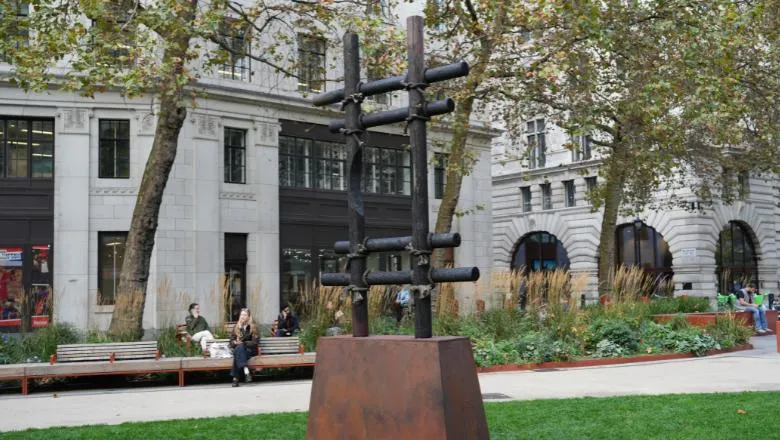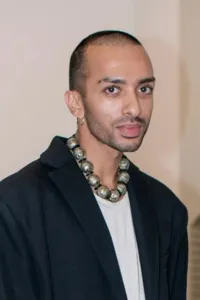While the concept tends to be understood mainly in spiritual terms, barzakh can also be translated as a physical “barrier” or “obstacle,” and is used twice in the Qur’an to describe the impenetrable border between fresh and salt water – where the river meets the ocean. Some Muslim philosophers even likened it to a dreamworld or a state somewhere between the material and spiritual realms.
Dr Taushif Kara Lecturer in Modern Islam, Department of Theology & Religious Studies
31 October 2024
New sculpture illustrates ‘space between death and the afterlife'
The Middle is a sculpture by artist, Aman Aheer and developed in collaboration with Dr Taushif Kara, is a reflection on the ambiguous concept of barzakh: an Arabic term used to describe the intermediate state between death and the afterlife.

The sculpture stands on public display next to St Mary le Strand church, on the Strand space until 30 November 2024. It is part of Lost & Found: Stories of sanctuary and belonging, a programme of arts and ideas curated by King’s Culture. Dr Taushif Kara is Lecturer in Islamic Studies in the Department of Theology & Religious Studies. He is especially interested in Muslim political thinking in the moments before and after decolonisation, and has ongoing research is on the concept of barzakh, including its intellectual history and contemporary uses.
In The Middle, Aheer explores these conceptual ambiguities with reference to concrete materials. The sculpture resembles various liminal or transitory structures such as a funeral pyre, burial stretcher, or ladder. When preparing the poles, the artist deployed the shou sugi ban technique, a Japanese method of preserving wood and making it more durable by partially burning it.
Drawing on different theologies and practices relating to death and mourning, The Middle asks the viewer to consider the precarious and often ambiguous space in between. What does it mean to live on the threshold, or exist on the border? And what does it feel like to seek sanctuary?

'I’m interested in the human desire to give form to the formless, and to make sense of the unknowable. The sculpture itself plays on various tensions; it is monumental and totemic, yet it also feels precarious; it is completely charred but only in order to preserve its structure; it feels like a portal, but we are unsure as to where it will lead.' – Aman Aheer, artist.
Find out more about the Lost & Found programme here
Aman Aheer is an artist working through several different media. Though primarily working through painting, his practice also incorporates both found objects and organic materials, including iron and waste. He is a graduate of Emily Carr University of Art and Design in Vancouver and has exhibited globally, including most recently at the Dystopia Biennale in Berlin. Aheer’s solo exhibitions include Twin (Chapter 6, Shanghai), body double (indigo+madder, London), and Man is Not a Bird (St Peter’s Church, Cambridge).
The Middle was made possible through the Creative Collaboration Seed Fund from King’s Culture, and an Arts Abroad grant from the Canada Council for the Arts.

